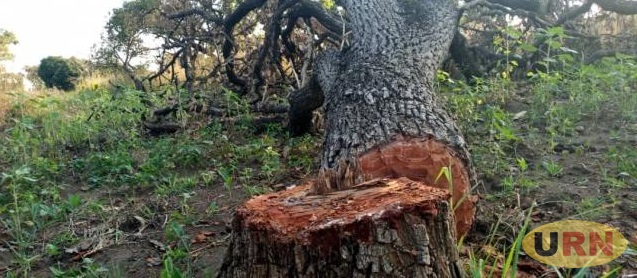
Clan leaders in Agago district have been at the forefront of the fight against the destruction of endangered tree species.
In December 2021, a group of 15 clan leaders from the district launched a year-long operation to arrest and penalize those found cutting down shea nut trees without authorization and in large numbers.
As one of the ways of fighting the continued destruction of shea nut trees, the clan leaders conducted a mini survey from August to December 2023, to ascertain the trend in cutting the protected tree species.
Kassimiro Ongom, the chief of the Patongo Clan, said during that period, they found that more than 20,000 shea nut trees were destroyed in Arum, Omot, and Geregere sub-counties, with the most affected villages being; Wipolo, Kazi-kazi, Olel and Okwang B.
Ongom however said as they carried out the survey, they were faced with several challenges such as aggression from the traders, and defiance from the locals who firmly believe that the trees are their only source of sustenance.
On May 19th, 2023, President Yoweri Museveni issued Executive Order No.3 of 2023 banning the mass trade in indigenous tree species, especially the endangered shea nut trees.
Kassimiro said despite the Executive Order, they found that the dealers in tree products are still cutting and destroying the trees on a large scale and transporting them throughout the night until dawn.
John Okidi, the Agago District Environment Officer, acknowledged that people are still going against the executive order which prohibits cutting of trees, but hastened to note that they are continuing to penalize nab and penalize them. Without giving figures, Okidi said they have already caught several culprits involved in destroying the trees.
Okidi hopes that as long as the district continues to penalize the tree destroyers, they will be able to protect trees and improve the tree cover, protect the environment, and reduce the adverse effects of climate change.
The district, with support from partners, set up a nursery bed at the district headquarters, and more than 750,000 seedlings were distributed to institutions and communities by October 2023, according to statistics from the district forest department.
Okidi said they are in the process of nurturing more tree seedlings to be distributed for the community to plant.
In 2023, leaders in the forest department at the district announced that they would plant 200 million trees in 10 years.
Okidi said the forest department is now monitoring the trees already planted, to track the survival rate of the tree species given out to the community.
“But also to give them the technical on how they can manage the trees they have planted,” Okidi said.
Richard Otwal, a resident of Okwang B Village in Arum sub-county is a repentant shea nut tree cutter.
According to Otwal, he was forced to cut down twelve shea nut trees because he had no other alternative source of income.
Otwal however said he wasn’t happy that he had to cut twelve shea nut trees. However, feels relieved that he used the money to start another income-generating activity, and saved twelve other shea nut trees which will help the environment and his children.
He commended the district for taking up the initiative to groom tree seedlings for distribution to replace the lost trees, saying it is not only a way of fighting climate change but a source of livelihood.
In 2016 the cultural leaders enacted a by-law banning the cutting of shea nut trees and two years later, the Ministry of Water and Environment suspended the felling, transportation, and trade in shea nut trees to prevent its extinction.
Nevertheless, several people are still cutting the shea nut trees, mainly for commercial charcoal purposes.
 The Independent Uganda: You get the Truth we Pay the Price
The Independent Uganda: You get the Truth we Pay the Price


